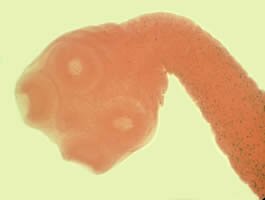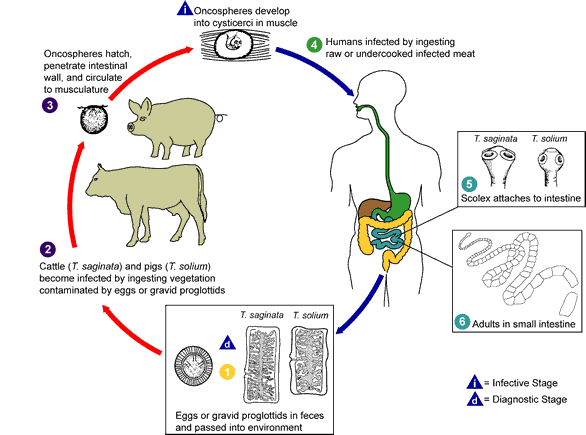Beef tapeworm (Taenia saginata)

 A beef tapeworm (Taenia saginata) is very long and flat like a ribbon. It has a small head containing adhesive organs, a short neck and numerous segments. They are able to absorb food through the whole surface of their body, by osmosis effect. The beef tapeworm has a well-developed excretory system and a perfectly expanded reproductive system where in every segment there are male and female organs (bisexualism). Mature segments filled with large amounts of eggs, separate from the tapeworm and exit the body with faeces. Its further growth takes place in an indirect host, mainly in muscles, but also in the liver or brain and other organs until it takes an invasive form of a blackhead. The blackhead has the shape of a blister and contains a head and some fluid. The disease caused by blackhead is called cysticercosis. Taeniasis has a wide geographical range.
A beef tapeworm (Taenia saginata) is very long and flat like a ribbon. It has a small head containing adhesive organs, a short neck and numerous segments. They are able to absorb food through the whole surface of their body, by osmosis effect. The beef tapeworm has a well-developed excretory system and a perfectly expanded reproductive system where in every segment there are male and female organs (bisexualism). Mature segments filled with large amounts of eggs, separate from the tapeworm and exit the body with faeces. Its further growth takes place in an indirect host, mainly in muscles, but also in the liver or brain and other organs until it takes an invasive form of a blackhead. The blackhead has the shape of a blister and contains a head and some fluid. The disease caused by blackhead is called cysticercosis. Taeniasis has a wide geographical range.
Infection sources
Beef tapeworms live mostly in humans whereas its larvas develop in cattle. People can be infected by eating raw or undercooked meat. The tapeworm lives in the small bowel of a human body, it is 4-10m long and contains 2000 segments. The ending uterus segments, exit the body through the anus. Every segment contains 100000 eggs which easily spread out in the environment. They are able to survive in contaminated soil for over a year. Their further development takes place in cattle where during 10-12 weeks they grow up to become blackheads. A blackhead is a blister, 7×4 mm, filled with fluid and containing invasive heads. After 3 months from infection, the tapeworm is fully grown and starts to release uterus segments. Beef tapeworms can stay in a human organism for more than dozen years, self-treatment happens rarely.






